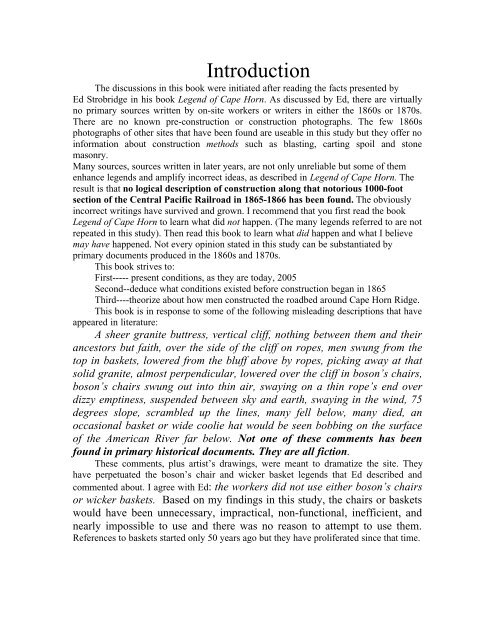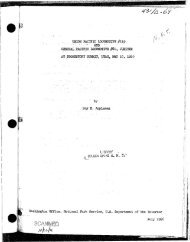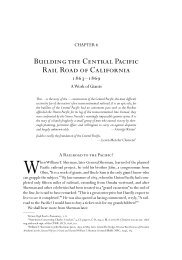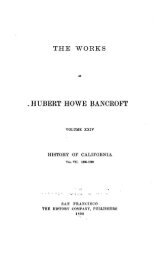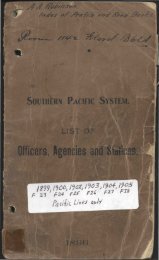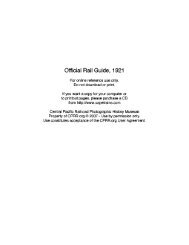Cape Horn Construction - Central Pacific Railroad Photographic ...
Cape Horn Construction - Central Pacific Railroad Photographic ...
Cape Horn Construction - Central Pacific Railroad Photographic ...
You also want an ePaper? Increase the reach of your titles
YUMPU automatically turns print PDFs into web optimized ePapers that Google loves.
Introduction<br />
The discussions in this book were initiated after reading the facts presented by<br />
Ed Strobridge in his book Legend of <strong>Cape</strong> <strong>Horn</strong>. As discussed by Ed, there are virtually<br />
no primary sources written by on-site workers or writers in either the 1860s or 1870s.<br />
There are no known pre-construction or construction photographs. The few 1860s<br />
photographs of other sites that have been found are useable in this study but they offer no<br />
information about construction methods such as blasting, carting spoil and stone<br />
masonry.<br />
Many sources, sources written in later years, are not only unreliable but some of them<br />
enhance legends and amplify incorrect ideas, as described in Legend of <strong>Cape</strong> <strong>Horn</strong>. The<br />
result is that no logical description of construction along that notorious 1000-foot<br />
section of the <strong>Central</strong> <strong>Pacific</strong> <strong>Railroad</strong> in 1865-1866 has been found. The obviously<br />
incorrect writings have survived and grown. I recommend that you first read the book<br />
Legend of <strong>Cape</strong> <strong>Horn</strong> to learn what did not happen. (The many legends referred to are not<br />
repeated in this study). Then read this book to learn what did happen and what I believe<br />
may have happened. Not every opinion stated in this study can be substantiated by<br />
primary documents produced in the 1860s and 1870s.<br />
This book strives to:<br />
First----- present conditions, as they are today, 2005<br />
Second--deduce what conditions existed before construction began in 1865<br />
Third----theorize about how men constructed the roadbed around <strong>Cape</strong> <strong>Horn</strong> Ridge.<br />
This book is in response to some of the following misleading descriptions that have<br />
appeared in literature:<br />
A sheer granite buttress, vertical cliff, nothing between them and their<br />
ancestors but faith, over the side of the cliff on ropes, men swung from the<br />
top in baskets, lowered from the bluff above by ropes, picking away at that<br />
solid granite, almost perpendicular, lowered over the cliff in boson’s chairs,<br />
boson’s chairs swung out into thin air, swaying on a thin rope’s end over<br />
dizzy emptiness, suspended between sky and earth, swaying in the wind, 75<br />
degrees slope, scrambled up the lines, many fell below, many died, an<br />
occasional basket or wide coolie hat would be seen bobbing on the surface<br />
of the American River far below. Not one of these comments has been<br />
found in primary historical documents. They are all fiction.<br />
These comments, plus artist’s drawings, were meant to dramatize the site. They<br />
have perpetuated the boson’s chair and wicker basket legends that Ed described and<br />
commented about. I agree with Ed: the workers did not use either boson’s chairs<br />
or wicker baskets. Based on my findings in this study, the chairs or baskets<br />
would have been unnecessary, impractical, non-functional, inefficient, and<br />
nearly impossible to use and there was no reason to attempt to use them.<br />
References to baskets started only 50 years ago but they have proliferated since that time.


